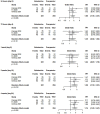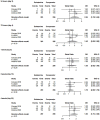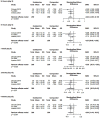Commentary on Cochrane review: "Ketamine and other glutamate receptor modulators for depression in adults with unipolar major depressive disorder"
- PMID: 36218274
- PMCID: PMC10399093
- DOI: 10.1177/02698811221123046
Commentary on Cochrane review: "Ketamine and other glutamate receptor modulators for depression in adults with unipolar major depressive disorder"
Abstract
Background: Cochrane recently published a review of esketamine and other glutamate receptor modulators in depression.
Aim: To address the limitations of the review, analyses of esketamine data were conducted to provide additional perspective to the reviewers' interpretation of their findings.
Methods: Response rate, remission rate, and change from baseline in Montgomery-Åsberg Depression Rating Scale (MADRS) total score were determined using data from all esketamine phase 2/3 registration studies of treatment-resistant depression (TRD) and, separately, all esketamine phase 2/3 registration studies of major depressive disorder (MDD) and active suicidal ideation with intent. Outcomes were assessed at all timepoints (i.e., 24 h, 72 h (MDD with active suicidal intent only), and 1, 2, and 4 weeks). Enrollment criteria of the TRD studies were different than those of the studies of MDD and active suicidal ideation with intent, resulting in differences in patients' clinical characteristics and depression severity between the cohorts. Thus, we did not compare results between these cohorts (as was done in the Cochrane review).
Results/outcomes: In the combined TRD studies, a statistically significant between-group difference favored esketamine plus antidepressant over antidepressant plus placebo at 24 h (based on response, remission, and change in MADRS score), 1 week (change in MADRS score), 2 weeks (response and change in MADRS score), and 4 weeks (response, remission, and change in MADRS score). In the combined studies of MDD and active suicidal ideation with intent, the between-group difference was statistically different, favoring esketamine plus standard-of-care over placebo plus standard-of-care, at 24 h (response, remission, and change in MADRS score), 72 h and 1 week (change in MADRS score), 2 weeks (response), and 4 weeks (response, remission, and change in MADRS score). For both study types, the between-group difference in outcomes was not statistically significant at the other timepoints.
Conclusions/interpretation: Esketamine improves response, remission, and depressive symptoms as early as 24 h post-first dose among patients with TRD and among patients with MDD and active suicidal ideation with intent.
Keywords: Esketamine; suicidal ideation; suicide risk; treatment-resistant depression.
Conflict of interest statement
The authors declared the following potential conflicts of interest with respect to the research, authorship, and/or publication of this article: All authors are employees of Janssen Research & Development, LLC (the developer of esketamine nasal spray [Spravato®]), with the exception of Dr. Mathews who was an employee of Janssen Research & Development, LLC when this work was performed. All authors are stockholders of Johnson & Johnson.
Figures






Comment on
-
Ketamine and other glutamate receptor modulators for depression in adults with unipolar major depressive disorder.Cochrane Database Syst Rev. 2021 Sep 12;9(9):CD011612. doi: 10.1002/14651858.CD011612.pub3. Cochrane Database Syst Rev. 2021. PMID: 34510411 Free PMC article.
References
-
- Caddy C, Amit BH, McCloud TL, et al.. (2015) Ketamine and other glutamate receptor modulators for depression in adults. The Cochrane Database Syst Rev 9: CD011612. - PubMed
-
- Canuso CM, Singh JB, Fedgchin M, et al.. (2018) Efficacy and safety of intranasal esketamine for the rapid reduction of symptoms of depression and suicidality in patients at imminent risk for suicide: Results of a double-blind randomized, placebo-controlled study. Am J Psychiatry 175: 620–630. - PubMed
Publication types
MeSH terms
Substances
LinkOut - more resources
Full Text Sources

